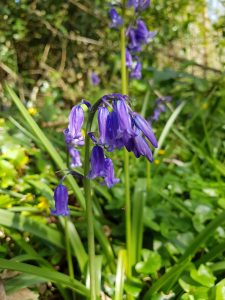Our native bluebell, Hyacinthoides non-scripta, otherwise known as the Common Bluebell, is an early flowering pollinator-friendly plant that naturally occurs in Ireland. The Irish name Coinnle Corra, means tapered candles.
Common bluebells can form beautiful blue carpets of colour from April to May and on warm days, they produce a delicate sweet smell.

They flower early to make the most of the sunlight reaching to the forest floor before our broadleaved canopy trees come into leaf.
Their appearance can be a significant event in our annual calendars as many of us head off to visit our favourite bluebell wood and enjoy this beautiful wildflower spectacle.
Common bluebells can be found in old woodlands and woodland edges, even at the base of old hedgerows, farm laneways and road verges. Indeed, their presence can indicate ancient woodland. They are a common and widespread species in Ireland, and it is estimated that 25 to 50% of all common bluebells may be found in Ireland and Britain. This makes the population in Ireland significant internationally.
 |
 |
Do pollinators forage on the Common Bluebell?
Yes. They’re a valuable source of early nectar and pollen for pollinating insects. Bees can also bite a hole in the bottom of the long tubular flower, reaching the nectar without the need to pollinate the flower, sometimes known as ‘nectar robbing’. Bluebells can reproduce sexually by seed or asexually by natural vegetative propagation.
Bumblebees recorded foraging on Common Bluebell include the Common Carder Bee, Buff-tailed Bumblebee, Red-tailed Bumblebee, Early Bumblebee and the Garden Bumblebee. Also, some of our rare and less common bees like the Hairy-footed Flower Bee, the Tree Bumblebee and the Large Carder Bee.
The small solitary Gwynne’s Mining Bee and the White-footed hoverfly Platycheirus albimanus have also been recorded foraging on Common bluebell.

|
 |
Are Common Bluebells in trouble?
Yes. Unfortunately, our love for bluebells led to the Spanish bluebell Hyacinthoides hispanica being introduced to the horticulture market. This is a concern as the two species can hybridise, with a possible threat to the genetic integrity of our native Common bluebell.
Can importing non-native plants put our native species at risk?
Yes. The Bluebell is an example of how the introduction of non-native bluebells, planted in our parks and gardens, may be threatening our native species. Spanish bluebells can breed freely with our native species, creating a hybrid plant with features from both species. This process of Spanish bluebells hybridising with our native Common bluebell, could mean the native species is changed forever. There is a concern that the hybrid bluebell may have the ability to outcompete native Common bluebell.
What’s the difference between the Common Bluebell and Spanish Bluebell?
At a glance, Common bluebell and Spanish bluebell can easily be dismissed as being the same.
A closer look can reveal some differences that will help you to distinguish between the two easily. Here are the key differences:
|
Common bluebell Hyacinthoides non-scripta |
Spanish bluebell Hyacinthoides hispanica |
|
|
Leaves |
Narrow leaves, about 1-1.5cm wide. | Broader leaves, about 3cm wide. |
| Flower | Deep violet-blue (sometimes white), narrow tubular-bell flowers, with tips that curl back. | Pale blue (often white or pink), conical bell-flowers, with spreading and open tips. |
| Flowers on one side of the stem. | Flowers all around the stem. | |
|
Stems |
Distinctly drooping stems. |
Upright stems. |
| Smell | A sweet smell. | No scent. |
|
Pollen |
Cream coloured pollen inside. | Blue or pale green coloured pollen inside. |
What can I do to help our native Common Bluebell?
- Never collect Bluebell bulbs from the wild.
- When buying Common Bluebell bulbs, make sure they have not been wild-collected and preferably have been grown on the island of Ireland to avoid any imported pests and diseases.
- When you visit your local Bluebell wood, tread carefully, avoid stepping on the bluebell leaves, as trampling can crush the leaves and weaken the plant as it can no longer photosynthesise.
And if you are lucky enough to have your own little patch of our native Common Bluebells? Cherish them.
For further information on Common bluebell Hyacinthoides non-scripta, Spainish bluebell Hyacinthoides hispanica and a Risk Assessment of Hyacinthoides hispanica, including H. non-scripta x H. hispanica. 2014.
Ireland’s Biodiversity guide to ‘Ireland’s Regulated Invasive Alien Plant Species’.
For further information on the All-Ireland Pollinator Plan visit our website All-Ireland Pollinator Plan » All-Ireland Pollinator Plan (pollinators.ie)
By Ruth Wilson, Farmland Officer, All-Ireland Pollinator Plan.

